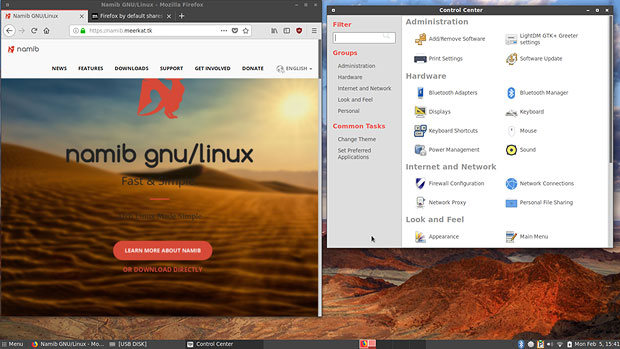
![]()
Namib is an ideal Linux distro for anyone who wants to ease into the Arch approach to computing.
Namib is a newcomer — the third and current release (version 17.11) arrived late last year. However, it makes up for its lack of age by its performance. Namib makes Arch simple.
Surprisingly very user-friendly as well as compatible with older computers, Namib also is very stable.
Since Namib is based on the Arch philosophy, it uses rolling releases so you do not have to reinstall the entire operating system every time a major update occurs. The Pacman package manager handles new system components along with security and application updates automatically.
Namib is very up to date.
A New Face for Arch
This little-known distro is developed and maintained by Meerkat Software based in Tokelau, a territory of New Zealand. It supports English and French.
Namib is a fully functional OS out of the box. The rolling releases give you cutting-edge software with ease-of-use and accessibility.
I often do not recommend Arch Linux or its derivative distros to unseasoned users. It is not worth the frustration and hassle in overcoming installation troubles to get started. That difficulty comes from a pervasive insistence by the pure Arch developers to rely on command line installation routines and specialized installer scripts rather than graphical interfaces.
Some Arch communities are changing, however. I was impressed with recent efforts by developers of ArchMerge Linux and Anarchy Linux to make Arch more suitable for newcomers as well as veteran Linux users unfamiliar with Arch.
Now Namib Linux takes the simplicity goal a big step closer to install-and-go simple.

Getting Namib Ready
Two things help Namib part simplify the path to using Arch. One is the live session setup with Calamares installer. The other is the MATE desktop.
Arch Linux offerings are designed to start with a bare-bones system. You can add software you want rather than ignore the bloat or remove what you do not want.
Most traditional Arch Linux options merely let you burn the downloaded ISO file to DVD to use as an installation medium. They usually do not boot your computer into a standalone demo mode. Arch Linux also is infamous for its troublesome installation and configuring processes.
This new class of Arch Linux Simplified is changing that approach. Namib loads smoothly from the DVD into a fully functional live session. It also puts an open window on the screen to continue with the installation process. Just click the cancel button to remain in live session.
When you are satisfied that Namib works with your hardware and accepts your wireless connection, click the desktop icon to begin the fully automated installation.
What’s Inside
Arch distros for the most part are designed for users to build themselves by manually adding a wide variety of applications from Arch repositories.
However, Namib Linux gives you more preinstalled software.
Included are the expected MATE accessories for handling file archiving chores, calculator, search and the Pluma clip manager. Also part of the stock software library is Eye of MATE Image Viewer, GIMP image editor and LibreOffice suite. Sound and Video tools include Brasero, GNOME MPV, mpv Media Player and Rythmbox.
The Namib developers stocked the distro with specialized tools that, along with the MATE control panel, take all of the mystery out of running the OS. They also built in preinstalled codecs to play multimedia files and for automatic installation of the necessary software for your hardware, such as graphics drivers.
System Tools
One of the strong points with the MATE desktop is the placement of most controls and settings in one location. Just look in the main menu for the Control Center app to configure personalized system settings.
Besides desktop settings, you will find essential admin and hardware settings there. Look in the Preferences category of the main menu for additional controls specific to the Arch environment.
Namib includes support for the easy installation and use of multiple kernels. A plus is access to the Arch User Repository for applications desirable for more experienced users.
Look and Feel
The MATE desktop has the appearance of classic Windows 7. A panel bar sits across the bottom of the screen. A menu button is at the far left. The right side of the panel holds the notifications area.
Right-click on an application listed in the main menu to place a shortcut on the favorites list or the desktop. Right-click on the panel to add applets to it and modify the panel’s properties. Right-click on the desktop to create folders and launchers, create a document, open a terminal, or adjust some details on the desktop.
MATE is a good desktop for new users. It also is a good choice to help you get comfortable with Arch fast.
Bottom Line
Why use Arch? It is a technically better Linux OS family line. However, that gain is offset by the technical expertise requirements for installation and maintenance of the Arch system.
I found Namib Linux to offer the ease and convenience of systems built around the Debian Linux family.
Hopefully Namib will offer one or two additional desktop environments. That would make the distro more appealing to users looking for something new.
Still, like everything else about Namib, MATE just works. This new distro is definitely worth a try.
Want to Suggest a Review?
Is there a Linux software application or distro you’d like to suggest for review? Something you love or would like to get to know?
Please email your ideas to me, and I’ll consider them for a future Linux Picks and Pans column.
And use the Reader Comments feature below to provide your input!























































Other reviews at:
(1) https://www.youtube.com/watch?v=Py1kZQaXRtM
"Namib GNU/Linux 1806 GNOME", by "DistroTube". 25 mins 36 secs.
(2) https://www.linux.com/learn/intro-to-linux/2018/2/namib-linux-makes-arch-linux-dream-new-users#comment-20641
"Namib Linux Makes Arch Linux a Dream for New Users", by JACK WALLEN, MARCH 2, 2018
Reviews might claim New Zealand as the origin of the distro. It is in fact CANADA.
Will now install the MATE version.
It has your answer that anyone should be able to follow right here:
https://wiki.archlinux.org/index.php/reflector
There is nothing hard or complicated about it. It is just the matter of knowing where to look for answers. Arch wiki for any Arch based distro should be first stop. You do not have to do anything with pacnew files if you read this. It even provides the examples.
Your answer is here in full details. You do not have to anything.
https://wiki.archlinux.org/index.php/reflector
The article fails to mention a few very important things.
First – this project appears to have rebranded outdated versions of manjaro tools (and even the new website mockup) and rebranded them.
It seems like they did a "search and replace" over the code – very likely a breach of license.
Further, they use a coinhive script to actively use installations on end-users machines to mine crypto currency, "instead of showing ads".
In short, I am suprised at this article and its advertisement for such a shady project.
I cannot edit the above post, but the second to last line is misleading. The Namib Linux forums openly state that the online resources for namib utilize cryptomining to ‘support the site’.
Up to now, no one has tested the installed distro itself for similar activity.
Thank you for expressing your concerns about the developer issues you cited about my review of Namib. First, please understand that my role in writing this review has nothing to do with advertising or positioning favorable comments about this Linux distro or any other software or hardware product. I select Linux distros for review based on their relevance and potential interest and usefulness. The developers do not know about the topic of a review until it is published.
That said, I contacted the developer team and asked for a response to the issues you raised. I received an unsigned email from the Namib account that provided some clarity to your concerns.
Here is a summary of that response:
1. The Manjaro tools are not outdated but are modified compatibility with Arch. The Namib website is based on an old Manjaro website design never made active that now serves as a mockup posted on github here [https://github.com/manjaro/homepage].
2) The developer does place a coinhive script in the OS. That was done to raise revenue instead of selling advertising.
However, that script is disabled by default and is currently not working. Namib users can choose to use it or not.
wondering if you have any basic thoughts on how namib compares to antergos or manjaro.
thanks.
I was wondering the same thing as well. One thing I would love to know is doing all these updates what does it do with the pacnew files. Does it change these on its own or like arch based distributions is the user responsible for this and also the screwing up the system when these are changed which I have done numerous times before.
Generally, Antergoss and Manjaro share many similarities as easier to use Arch-based distros. They both are somewhat successful in making Arch simpler to install and use. I think Manjaro more closely resembles the ease of Ubuntu and Linux Mint. Manjaro is still balky to install and sometimes gives me troubled performance. I find that Antergos is much smoother in its processes.
That said, Namib seems to have built into its Arch base an even easier and less intimidating — and more successful installation process. It just has a friendlier feel and is more inviting to new adopters without a solid background in using all things Arch.
However, a big drawback with Namib for new users that I did not mention in my review is the lack of much forum activity and helpful user support. Heck, I could not even get the user guide to download, and the community does not let you read it online.
The Namib distro is still hooked to the hip of Arch Linux. So you must be careful with the pacnew files as with any Arch environment. Namib is still prone to issues that can easily mess up the system. I did not think this was a concern at first. But the more I use it, the more chances exist for something going wrong.